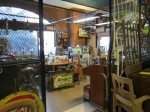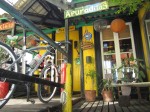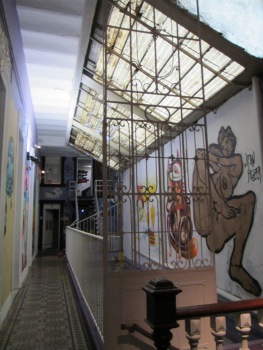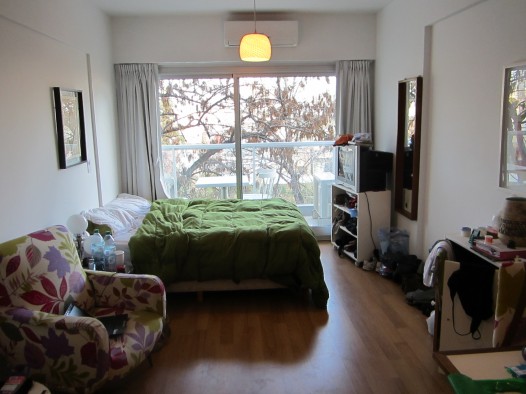Archive for category Uncategorized
Tigre and the Delta: “Pura Naturaleza” Just Outside of Buenos Aires
Posted by mandietuesday in Uncategorized on July 7, 2012
Kristi and I had read about (and heard from several locals) a day trip to a town called Tigre, which is on the Parana Delta about an hour and a half outside of Buenos Aires. As always, figuring out the transportation was a full 3/4 of the adventure, but we prevailed!

 There are two trains that reach Tigre, the more scenic (and therefore more expensive) Tren de la Costa, and the much lower-cost but more boring TBA line. We chose to take the Tren de la Costa for the ride out there, which cost us .80 pesos to take the Mitre line from our stop until Mitre, walk through a small and very unexpected vintage fair to the Maipu station, and then 16 pesos for a tourist ticket (without an option for another type of ticket unless you’re an Argentine resident) which allowed us on/off privileges for the entirety of the ride there.
There are two trains that reach Tigre, the more scenic (and therefore more expensive) Tren de la Costa, and the much lower-cost but more boring TBA line. We chose to take the Tren de la Costa for the ride out there, which cost us .80 pesos to take the Mitre line from our stop until Mitre, walk through a small and very unexpected vintage fair to the Maipu station, and then 16 pesos for a tourist ticket (without an option for another type of ticket unless you’re an Argentine resident) which allowed us on/off privileges for the entirety of the ride there.
We chose to get off at the Barrancas stop first, because it had some cute little buildings as we pulled into the train station. We ate at a restaurant called El Molino, which had a kayak/windsurfing/scuba  school and such attached. Adorable view, very relaxing, fun ambiance, very mediocre food. I mean, I love fake cheese more than most people, but a 24 peso plate of fake cheese and stale chips does not satisfy my nacho cravings.
school and such attached. Adorable view, very relaxing, fun ambiance, very mediocre food. I mean, I love fake cheese more than most people, but a 24 peso plate of fake cheese and stale chips does not satisfy my nacho cravings.
Boarding the train again, we got off at the next stop because everyone  said that San Isidro was THE stop to explore along the way. We enjoyed delicious iced coffee (and I made up for the lackluster nachos with a side of french fries, as usual) and wandered up to the cute little cathedral in town. Being winter, most things were closed (this is a repeating theme, by the way) and we hopped back on the train to take it all the way to Tigre soon after. Also, I may or may not get excited when I see bars/restaurants/any sort of establishment that have my name. That is all.
said that San Isidro was THE stop to explore along the way. We enjoyed delicious iced coffee (and I made up for the lackluster nachos with a side of french fries, as usual) and wandered up to the cute little cathedral in town. Being winter, most things were closed (this is a repeating theme, by the way) and we hopped back on the train to take it all the way to Tigre soon after. Also, I may or may not get excited when I see bars/restaurants/any sort of establishment that have my name. That is all.
 The town of Tigre itself? In a word, adorable, but I had the lingering feeling that it would be about a hundred times more awesome during the high season. Many shops were closed, particularly in the famed Puerto de Frutos, though this was probably for the best considering I had just enough pesos left to get me home after buying a surprisingly well-priced purse that was just the right size to fit my moleskine and a wallet. Excellent. We spent several hours just wandering around the city and river-gazing, however, and it was a fantastic little jornada outside of the bustle of the city for a day!
The town of Tigre itself? In a word, adorable, but I had the lingering feeling that it would be about a hundred times more awesome during the high season. Many shops were closed, particularly in the famed Puerto de Frutos, though this was probably for the best considering I had just enough pesos left to get me home after buying a surprisingly well-priced purse that was just the right size to fit my moleskine and a wallet. Excellent. We spent several hours just wandering around the city and river-gazing, however, and it was a fantastic little jornada outside of the bustle of the city for a day!
On the way back, we chose the boring TBA line, which cost a grand total of 2.15 pesos (1.35 for the 50 minute ride from Tigre to Retiro, and .80 from Retiro back up to our stop at Ministro Carranza). I quite like how we split the entertaining from the cheap, and would recommend doing it half and half if you’re interested. Granted, 16 pesos is just over $3.50 at the current exchange rate, so it’s not like it would have exactly broken the bank, BUT $.47 is obviously less and on a grad student budget, it’s the little things that count 🙂
Public Transportation in Buenos Aires: Or, Adventures in Lack of Integration
Posted by mandietuesday in Uncategorized on July 2, 2012
I love public transportation with all of my heart. I am all about subways and trains and buses (sometimes – I’ll get to that) and other forms of mass transit that get me from point A to point B cheaply and occasionally quickly. New York City has been fantastic in that regard, as you can imagine. However, while Buenos Aires boasts a variety of public transportation options, it’s been a bit of an ordeal figuring out where the subway stops are actually located, where the various independent train lines run and how they are(n’t) connected, and which bus will get me at least in the right direction. More on those in a moment.
Sidenote: it doesn’t help at all that a lot of maps are oriented with north to the top of the map, placing the water along the right hand/eastern side of the map, while others are oriented with the water to the bottom of the page.
As a general rule, though there are of course exceptions, my ranking of public transportation is thus:
- Subways. Metro, subte, the tube – no matter what you call it, I adore them. The best part is how every stop is always fixed. They’re not going to go off track (I mean, they can run on a different track in New York, but that’s a whole different story) or happen to stop on the next street over just because they feel like it. You can easily keep track of where you need to get off (either by reading the station names as you arrive and looking at the maps posted inside of the trains, or by counting ahead of time how many stops you have to go – this is particularly handy with non-Latin alphabets). They’re generally well-marked.
- Trains/trams. I’ve come across them less often than subways and buses, but they seem to do the trick. Sometimes don’t have as wide of a network within a city itself or tend to hit the tourist areas and that’s it, but they’re on my a-okay list.
- I rather dislike buses. They can go off “track,” they can skip a stop, maybe I don’t realize we’re on the street I want and by the time I hit the button to get off we missed it and I have to wait for the next one, maybe they just stop running but there’s nobody making an announcement at the bus stop to let you know that, etc.
Keeping that in mind, my opinions of the public transportation in Buenos Aires are on the slightly surprising side! Again, back to the major issues I’ve found (and how I’ve attempted to resolve them):
- Where the subway stops are actually located.
The map of the Subte here in Buenos Aires is fairly straightforward. This particular map even tells you what streets you’re going to be getting off on. Since I’ve been getting to know the city better, this has been mostly okay, but when I’m going to a new area of town, it takes me awhile to connect the stop on the map with the map of the area I’m going to. This is apparently harder than it looks or I’m doing something wrong. Googlemaps doesn’t show the stops, also.
As an aside, the subway is actually fairly limited in its scope here. It connects the city center well, but we’re living at the Ministro Carranza stop on the D/green train, so it’s the only train that’s accessible from our apartment but it’s a long ride to connect with anything else. Also, most of my interviews and research sites have been well outside of the reach of the subte in the afueras of the city.
The subway costs $2.50 ARS each ride, independent of distance, and there are no discounts for multiple rides purchased at once. I’ve been purchasing 10 ride tickets.
- Where the various independent train lines run and how they are(n’t) connected.
The train system within the city and its outskirts is quite extensive. However, as most of the tracks are run by different companies, it can be a hassle to figure out which of the trains connect, who’s running what, and which stops belong to which company. Lucky, I’ve figured out that the station that’s closest to my apartment (adjacent to the Ministro Carranza subte stop) is also called Ministro Carranza, and the Mitre and J. L. Suarez lines of TBA, which runs both the Mitre and Sarmiento lines, both run here. I’ve since used both of these lines, and once you get an idea of how it works, it’s handy. I did realize that when coming back when it was dark the other night, the stops are not at all lighted, so if I didn’t know what stop I wanted exactly and when to look out for it, I may have missed it.
The trains are $.80 ARS each way, which is the cheapest option that I’ve found.
- Which bus will get me at least in the right direction.
Oh, buses. I have been very surprised with the buses (usually called “colectivos”) here. Granted, I’ve only taken two separate lines, but buses are incredibly easy to use here. Used by something like 10 million people per average workday, they cover the vast majority of the capital and the outskirts. I’ve found a website called Omnilineas that is a godsend. You just click on the area you’re leaving from and where you want to go, and it gives you the various options that run by both of those! Considering that I often don’t have a direct address of my destination, just a park name or something, this has been much easier than using the address option. When I go from Palermo to Liniers, it’s a distance that Google Maps says would take 35 minutes to drive. I assumed it meant a bus would take at least an hour, but it turns out these are new “metrobus” lines that have a designated bus lane, bypassing traffic with ease! It was 35 minutes flat, including stopping at each of the 18 designated and well-marked bus stops. I pick it up on Honduras and take it to the end, to the Estacion Liniers.
The bus prices vary depending on the length of the ride, with a maximum price of $1.25 ARS.
One final note: as an attempt at some integration, the city introduced the SUBE card in 2009, which allows refills of up to 100 pesos at a time and can be used to pay for the subte or on buses. While I considered getting this card, it requires signing up with your passport at a center or post office and paying 10 pesos for the card itself. It would be a good idea for someone spending a significant amount of time here, but since I’m only in the city for a month and don’t use transportation every day (or use the train, which isn’t connected to the SUBE system), I’m just hoarding my coins to use on the bus.
“The Beautiful Game” in Buenos Aires: Transnationalism through Sport
Posted by mandietuesday in Uncategorized on June 26, 2012
One of the things that I love the most about my thesis topic is the reaction I get to the inevitable “so, what are you writing your thesis on?” question. When this question is asked by a professor or fellow grad student, I have a slightly longer response prepared, but when it’s asked by a casual acquaintance, my first answer is simply: “Soccer.”
I first started playing soccer when I was three years old; while I was never the fastest (by far) or the most skilled at footwork, I continued to play and love the sport through high school and onto college (and grad school!) intramural teams. I attended the 2010 World Cup in South Africa, obsessively follow Spain as a national team and Barcelona as a club, and yet had never really considered studying fútbol in a more academic way until I started at NYU. As it turns out, soccer is heavily studied by various academic fields – sociology, anthropology, history, ethnic studies, and even mathematics (statistical analysis), economics (the sport brings in billions of dollars worldwide), and science (does heading a soccer ball damage your brain? Are successful soccer players better thinkers than non-players?). For a sport that originated in mid 19th century Britain, it has spread across the world remarkably, and it would be hard to imagine modern-day Spain, Brazil, or Argentina without also picturing their fervent dedication to club teams, national teams, and the sport at large.
The research I’m doing while in Buenos Aires, then, somehow managed to work its way from “I want to go to South America and talk about soccer” to my current working research question: “With full awareness of the implications of the intersection of race, nationality, identity, and soccer within the Bolivian community in Buenos Aires, how and to what extent does this particular immigrant population use soccer to either negotiate integration into the local society or to sustain their distinct ethnic identity?” In brief, I hope to use soccer as a lens to understand the issues of transnationalism, migration, and discrimination that inevitably arise in this context.
I had been warned by many (professors, grad students who had completed their research already, and common sense) that the process of finding people who could help with my research and willingly be interviewed could be a difficult and tiring process. I’m not sure if I was just a researcher who spent her entire life helping burgeoning graduate students in a previous life and therefore karma is kicking in full speed, but I have been incredibly fortunate in this aspect. As this card I found in the San Telmo market proclaims, “lo importante no es saber, sino tener el telefono de quien sabe.” Truer words have never been spoken!
To begin with, there are two professors at the Universidad de Buenos Aires that are basically the academic experts of all things relating to fútbol and identity in Argentina. I met with Roberto Di Giano two days after arriving in Buenos Aires, and spoke with him at length about the fundamentals of soccer in this country, the history behind it, and the issues of discrimination and racism that are quite prevalent today. I will be meeting with the other professor, Pablo Alabarces, this coming week. I feel so fortunate to be able to meet with them.
Secondly, one of the NGOs that works with the Bolivian community in Buenos Aires has been helpful beyond what I could have hoped for. Called FUNCRUSUR (Fundacion Comunitaria Cruz del Sur), they are headquartered in the “microcentro boliviano” neighborhood of Liniers and work in various areas including health care, community involvement, legal issues, education, and diversion. I met with the NGO’s director, Dr. Manuel Cervantes, and he has connected me with a variety of individuals that will be able to help in the specific aspects of my research. (As a side note, I’ll be speaking about my project on the NGO’s community radio station tomorrow in the 1pm – 2pm slot [one hour ahead of EST] – it streams live online, so listen if you get the chance!)
To sum it up, I have been ridiculously lucky in so many ways already – and I haven’t even been in Buenos Aires for a full week yet! Not only have my contacts been helpful and forthcoming, but they continuously connect me with others that they think will be able to help as well. Perhaps most importantly, however, is the fact that I’m realizing more and more that while my project can perhaps seem silly on the surface, there is a mountain of incredibly important issues underneath just waiting to be discussed. Dr. Cervantes stated that one of the main reasons his NGO reaches out to adolescents through activities such as art and sports is: “Para que no tengan verguenza de su identidad, no tengan miedo de su cultura, y entiendan otras culturas.” [“So that they’re not ashamed of their identity, they’re not afraid of their culture, and they understand other cultures.”]
Yes, I’m talking about soccer, but it’s so much more than just a sport.
Just a little touch of star quality – Hello, Buenos Aires!
Posted by mandietuesday in Uncategorized on June 23, 2012
Buen dia! I’ve only been in Buenos Aires for five days now, but we’ve done so many things in that time that it feels like much longer!
Highlights of travel:
- Kristi’s connecting flight was canceled, so she had to arrive a day late. I hastily made a reservation at a hostel about 20 minutes away from my apartment, since I couldn’t check in without the money that we had decided Kristi would hold since we KNEW she would get here (and we all know that flying standby can be an adventure!) – thanks, irony.
- I actually slept for a few hours on the plane, which is a small miracle in itself.
- For future reference for everyone else: when you leave the airport, take the Manuel Tienda Leon bus to the centro. There, you get off the bus and they’ll transfer you to a car (along with a few other people in the same area) and take you to your hotel within a 5km radius. It’s only 75 ARS (about $17 USD), so a quarter of the price of a taxi, but fairly quick and very painless.
I found out while looking at the hostel page later that they explicitly said THIS IS A PARTY HOSTEL,  which is not exactly what my old body wanted after two days of travel, but it is what it is. I did make friends with one of the workers there, if by “make friends” you mean “he held the door open for me when I came back from the grocery store and told me he recognized me and I realized it was because I walked in on him in the bathroom earlier that day,” but hey, I’ll take what I can get!
which is not exactly what my old body wanted after two days of travel, but it is what it is. I did make friends with one of the workers there, if by “make friends” you mean “he held the door open for me when I came back from the grocery store and told me he recognized me and I realized it was because I walked in on him in the bathroom earlier that day,” but hey, I’ll take what I can get!
The hostel was a very cool, funky space, however.
Kristi arrived the next morning and we checked into our piso!
Why yes, we are swanky (and didn’t even really know it…).
And on the inside:
(Kristi, modeling her… guide book? I think?)
Clearly there isn’t an overabundance of space, but it’s perfectly functional for what we’re using it for. Plus, our building has a washer AND dryer, which is insane, so that’s fantastic. And our comforter is comfy! And we have a little balcony with a table and chairs!
The first day we were here was a Wednesday, which also happened to be National Flag Day (which commemorates the birthday of Manuel Belgrano, the creator of the Argentine flag). This means that everything was closed, which meant that when we were surprised by the fact that our apartment uses Australian/Chinese outlets instead of Argentine ones, there was nowhere to buy adapters. We’ve since done some research and realized that it appears the country is in the process of switching to these types of outlets, but apparently neither Kristi nor I came across this in our preparations, as we both only brought converters for the old style. We found a hardware store that sold them on Thursday, though, so all is well!
I’ll be updating soon with an actual research post (and be excited – I’ve been having amazing luck and we’re incredibly fortunate to have some awesome contacts here, so it’s getting good!), but for now, off to explore the city some more 🙂







